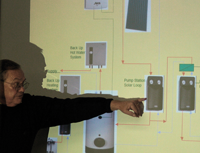Blog Post
Solar Hydronic Radiant Space Heating


Jack Mann, the presenter, has six panels on his own roof and the rest of the necessary gear in his basement for heat and domestic hot water for his 2,500 ft2 Rhode Island ranch. (It's interesting to note that the supply and return pipes between the storage tank and the rooftop array are corrugated [flexible] stainless steel.) In Jack's case, the system reduced their oil consumption by 70% while also providing heat for their pool, and for melting snow in the winter. If you don't have a swimming pool to displace the excess heat in the summer, you'll need to get creative. Nobis has options, all of which involve some form of heat sink. It's a shame it can't be stored for long-term use (or sold to your neighbor). He did say you could add more tanks—a typical installation has 270 gallons of storage. Another option is wrapping the foundation with PEX. If you really wanted to go all out—and this is not a Nobis project, but was mentioned by someone attending the presentation—you could do what they did at Drake Landing Solar Community in Alberta, Canada, which is to flow excess heat into a borehole thermal energy storage system. See EBN coverage Stored Solar Heat Warms Alberta Development and Solar Thermal District Heating Comes to North America. Andy Cay, a proponent of net zero energy homes and president of the local Habitat for Humanity chapter, also attended the presentation. He mentioned a nearby Habitat house built this year that uses long term storage of solar heat. Basically, solar panels direct heat into PEX buried in eight feet of sand in a superinsulated container below the basement slab during the summer, with the hopes of storing 4-5 million Btus that will be tapped during the cold Vermont winters. Stay tuned for the results. Getting back to Nobis, the payback for a system like Mann's—which costs between $16,000 and $25,000—is five to eight years. A few years ago, the payback period would have been substantially longer. It goes without saying that the recent spike in the price of oil helped shortened the payback period.Back to Mark: It also should go without saying that these sorts of systems work best as part of an overall strategy that includes heavily insulated, tight envelopes and appropriate footprints. And one more thing to chew on: our fearless leader Alex Wilson, in his book Your Green Home, characterizes radiant-floor heating as "a great heating option for a poorly designed house." A full-out radiant floor system, he argues, is overkill for a super-efficient house, which could be heated with a point-source heater or two. And in a well-designed, well-built home, the romantic warm-foot thing touted for radiant floors won't happen without overheating the place. Read the EBN feature, Radiant-Floor Heating: When It Does—and Doesn't—Make Sense." Check DSIRE—the Database of State Incentives for Renewables & Efficiency—to find information about state, local, utility, and federal incentives for purchasing and installing renewable systems.
Published November 30, 2007 Permalink Citation
(2007, November 30). Solar Hydronic Radiant Space Heating. Retrieved from https://www.buildinggreen.com/blog/solar-hydronic-radiant-space-heating



Add new comment
To post a comment, you need to register for a BuildingGreen Basic membership (free) or login to your existing profile.